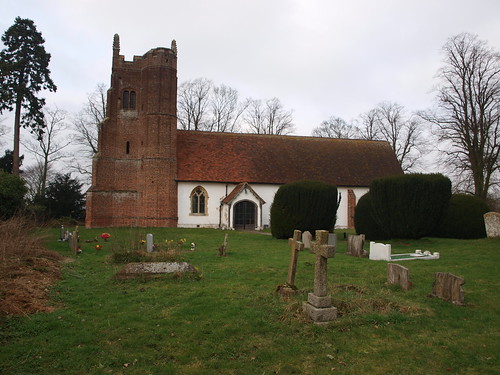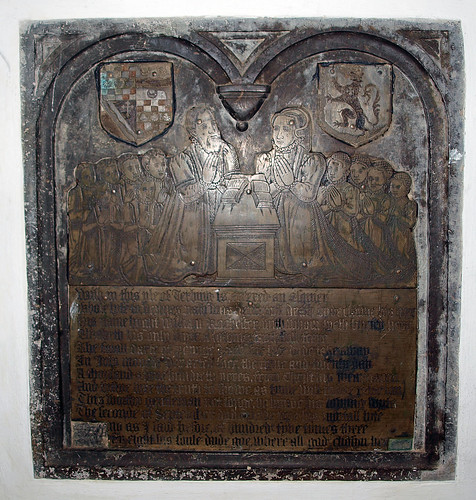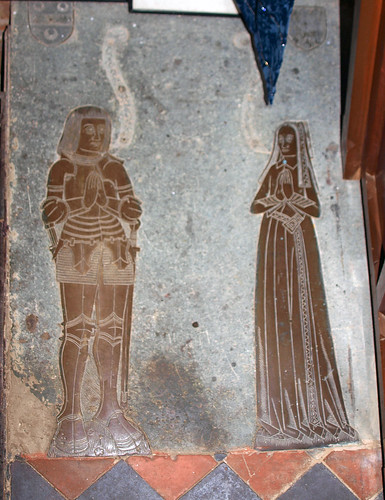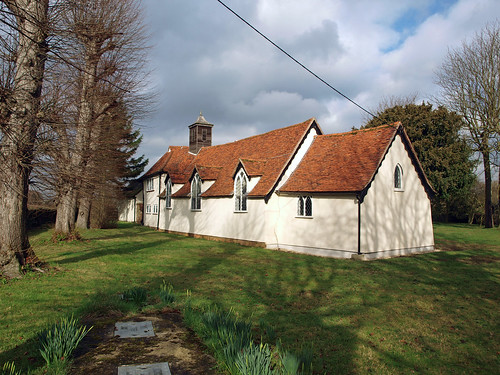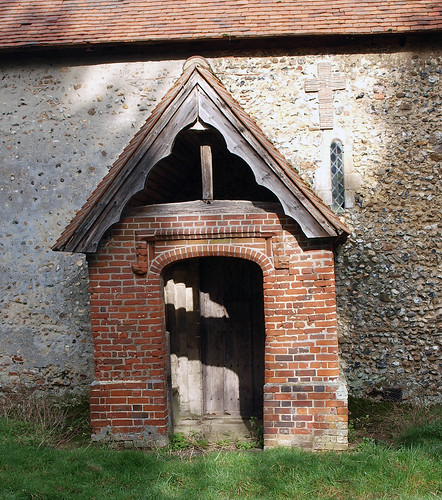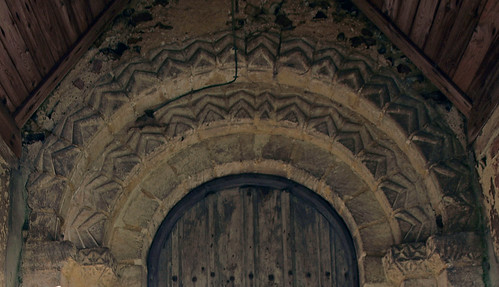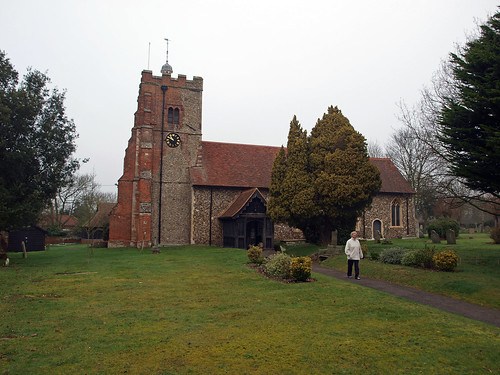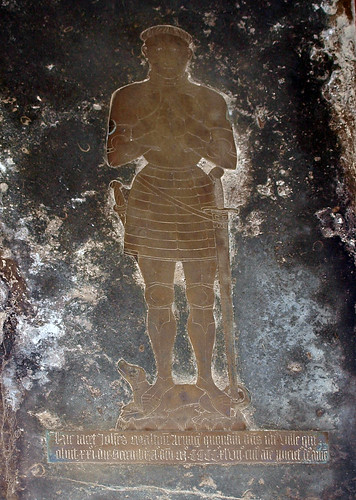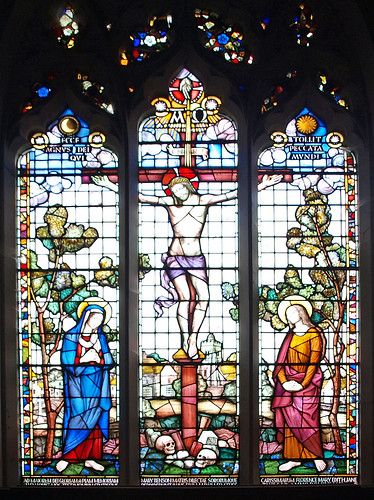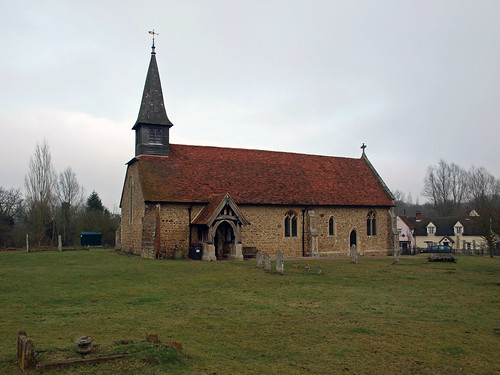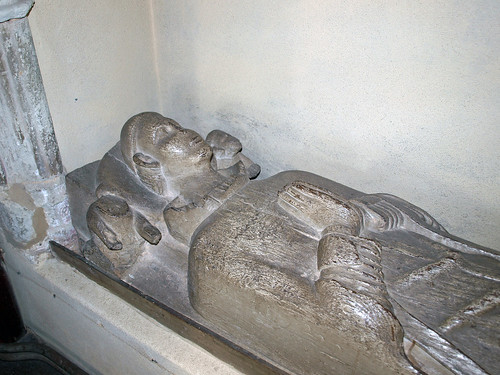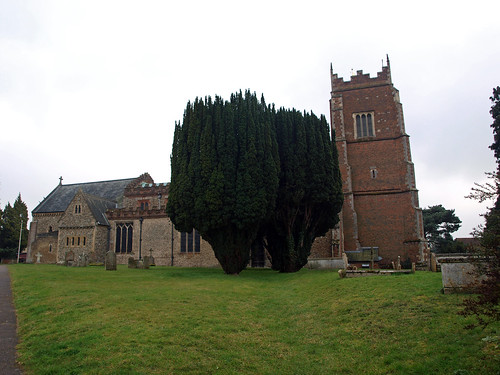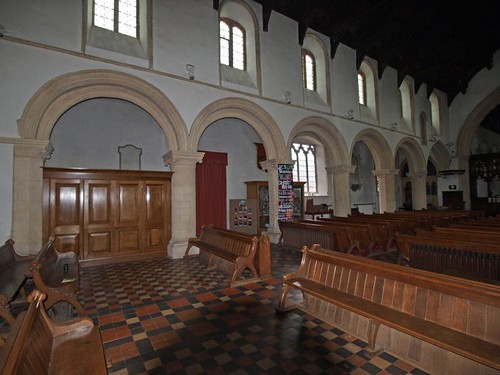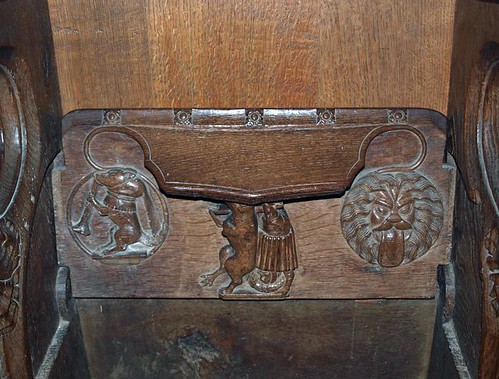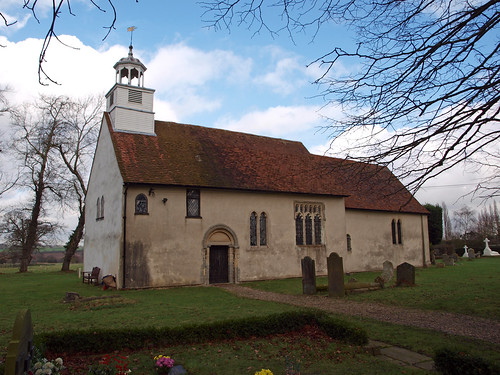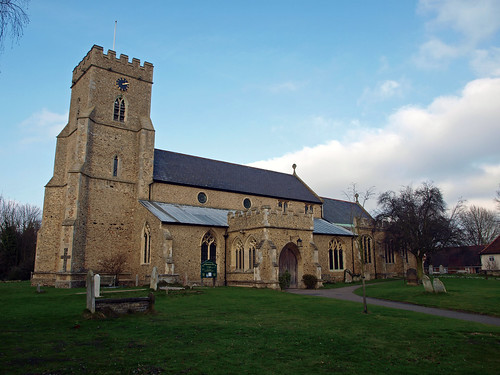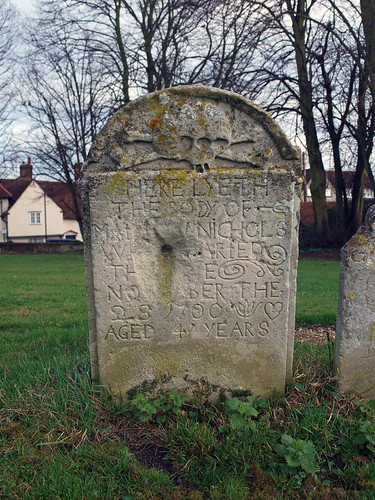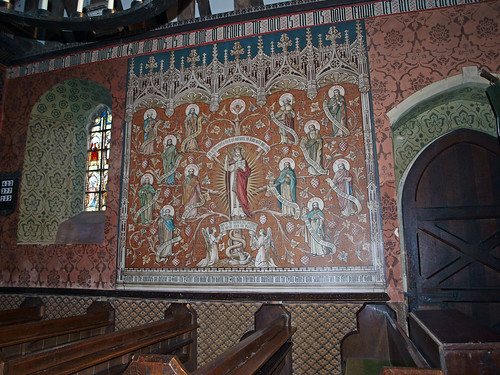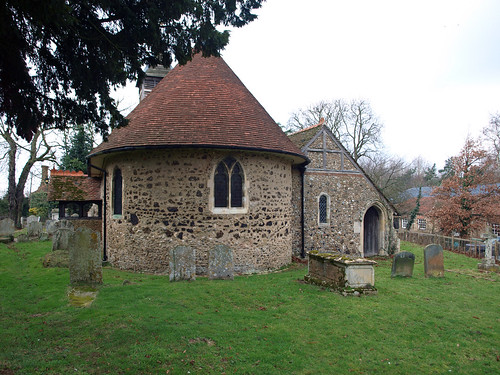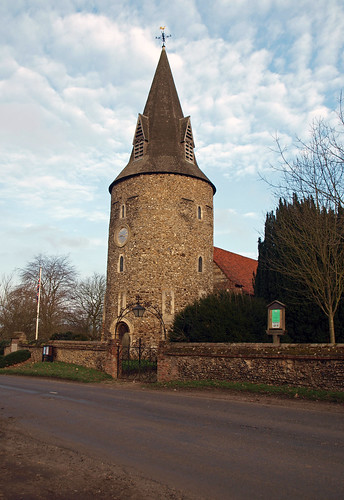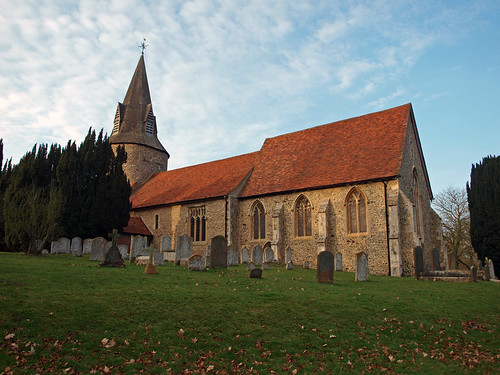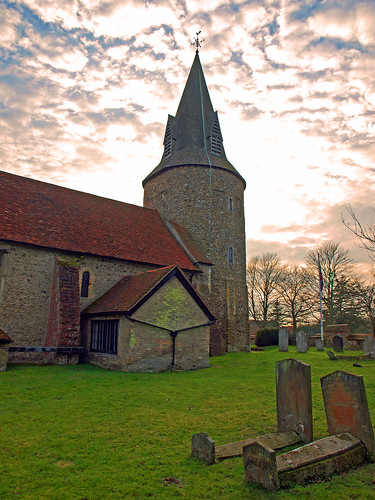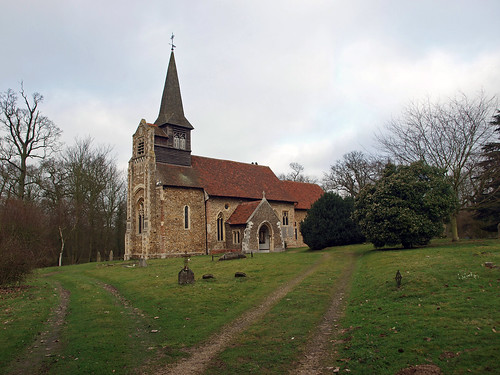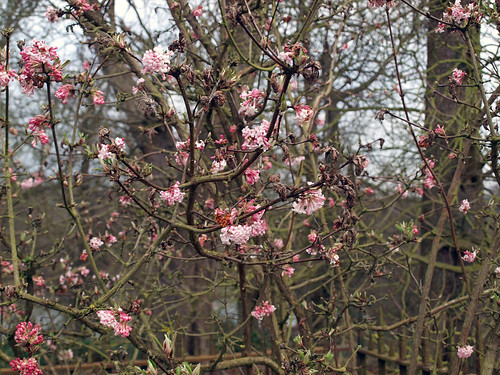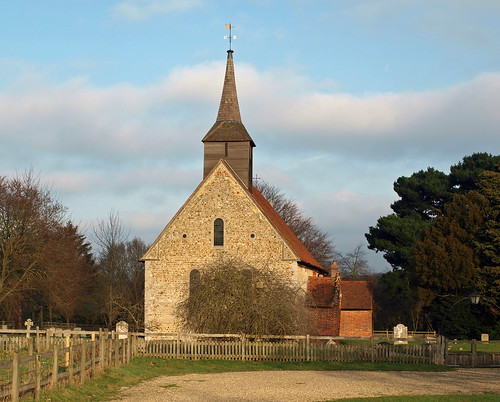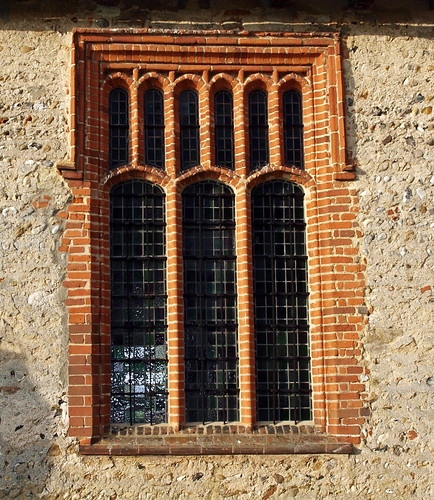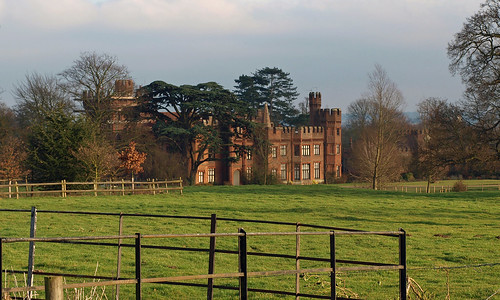The churches in this part of Essex tend to have brick built Tudor towers and All Saints is no exception with an octagonal stair turret. The body of the church is whitewashed and it sits outside of the village besides an old farmyard and farmhouse. A pleasant site but having peered through the windows I decided against searching out the keyholders and pressed on to Castle Hedingham. Given that Hedingham was locked with no keyholders perhaps my time would have been better spent here.
ALL SAINTS. In 1505 in a will £20 was left for the building of the tower. It is indeed a fine specimen, though not high. Red brick with blue brick diapers, diagonal buttresses, high stair turret, battlements and brick pinnacles. Brick W doorway and brick W window of three light with depressed pointed head and intersecting tracery. The rest of the church indifferent. - CHEST. Heavily iron-bound; C13. - SCREEN. With one-light divisions, ogee heads and some panel tracery above.
WICKHAM ST PAUL. It has belonged to St Paul’s Cathedral for a thousand years, a little link in Essex with the heart of London. Its houses are round a pleasant green, but its church is half a mile away by a farm, and we come to its porch beneath archways of roses. It was standing much as we see it before old St Paul’s perished in the Great Fire. Its fine brick tower is Tudor and has a door to the stair turret, which has been opening for 400 years. Part of the nave is 12th century, and the chancel was refashioned in the 14th century. One of the bells has been here about 500 years; and just as old are the nave roof and the great treasure of the church, a fine chancel screen with much delicate tracery. There is a 13th century chest bound with iron, a Jacobean altar table with a new top, and fragments of 15th century glass including a lion’s head.
Flickr set.
Thursday 24 February 2011
Terling
All Saints is a curious mix of old and new and is another church that has suffered from the attentions of the Victorians, added to which it "suffered much damage by enemy action during the world war 1939-1945".
It does, however, contain three really good brasses to the Rochesters - Sir John d.1514, William d. 1556 and John 1584. The chancel has a series of wall monuments to the Strutts ranging from 1919 to 2004 and a rather odd brick built mausoleum tacked on to the chancel takes them back to 1769.
ALL SAINTS. The best piece is the W tower of 1732 with arched doorway and arched windows, their surrounds consisting of rustication of alternating sizes. The rest not impressive from outside. C19 N aisle, completely renewed S aisle. The chancel seems to be of the C13. It has one small lancet window on the N side, and otherwise windows of c. 1300. Nice C15 timber porch. Inside, three-bay C15 N and S arcades with octagonal piers with concave sides and wave moulded arches. The low many moulded tower arch is proof of the existence of a previous C13 tower. - FONT. C13, octagonal, of Purbeck marble, with two shallow blank pointed arches on each side. - COMMUNION RAIL. Early C18, with slim twisted balusters. - BRASSES. Two groups of kneeling figures, of 1558 and 1584.
TERLING. The Terling countryside, through which the little River Ter flows at times under great forest trees, has a museum piece of its own in a smock mill with fine white sails 66 feet across, still working. It has one of the finest modern houses in Essex, home of the Rayleighs, standing in a magnificent park of 200 acres with the river flowing through it, and scattered about are farms and cottages that were here in our Tudor Age and must have been seen by Henry the Eighth, who had a palace here.
The village is rich in overhanging gabled roofs and Tudor chimneys. A grotesque little man crouches to bear a heavy beam at Eryat’s Farm, and the manor house, a dwelling-place of sheer delight, has 15th century foundations, windows of the two succeeding centuries, richly moulded timbering, and a view into the great park across its old-world garden. We do not wonder that here our great Tudor king lived in splendour, or that great folk lived here before him. The palace has vanished, but we know that here was a Norman chapel which was the scene of an act of ingratitude on the part of another King Henry that Bluebeard himself could hardly have surpassed for calculated cruelty. Here it was that Hubert de Burgh was forced from his sanctuary and carried off to the Tower by the young Henry the Third he had befriended.
The ruthless king had drawn his sword on Hubert, who was Justiciar of England, and had called him a traitor, and on Hubert seeking sanctuary in the chapel here had sent men down to fetter him and carry him off to the Tower. On the Bishop of London threatening to excommunicate all concerned, the king released the captive, but, in any case, before the bishop’s intervention the village smith, being ordered to fetter Hubert, had stubbornly refused. The king persisted in his persecution of the Justiciar, however, and though he dare not put him to death, finally sent him in chains to the Tower, from which Hubert escaped to Devizes and took sanctuary in the beautiful Norman church of St John, which would then be new. He was ultimately reconciled with his royal master. Far the better man of the two, Hubert is known in Shakespeare as the man who refused to put out Arthur’s eyes at the bidding of the ruffianly King John, and in history he is famous, it has been said, for being the first statesman "to convert the emotion of nationality into a principle of political action."
It is one of the few villages that have an ancient chapel. Across the green outside the churchyard stands the little Congregational building which has been here 250 years. It has a 17th century brass candelabra, by the light of which its people have sung their hymns since John Bunyan died; there are 12 branches, and a bird sits on the top. The church stands by the manor house, approached through a porch which has still its medieval timbers. The tower, crowned with a shingled spire with a dove for a weathervane, and carrying its bell outside, is of red brick and white stone, and is one of the 18th century towers, joining a 13th century wall. The church has brass portraits of William Rochester and his wife, who may have seen Henry the Eighth pass by, for they were laid here in the terrible reign of Mary Tudor. Their ten children kneel with them. On another brass 12 children kneel in groups with two mothers and their father, John Rochester, who died in the days of Queen Elizabeth.
In a quiet corner of the churchyard, joining the garden of Terling Place (which has a small gate into it), is a simple monument of red sandstone on which are the words, "For now we see in a glass darkly, but then face to face." It is the grave of one of the most learned men who ever lived in England, John William Strutt, third Lord Rayleigh. He was born at Maldon a few years after the Victorian Era began and lived till the end of the Great War.
He saw science revolutionised and played no small part in the revolution, and for nearly half a century he carried on his work at Terling. Learned as he was, he had the rare quality of making subtle things seem simple. In his collected works are 440 separate papers. They issued frequently and rapidly from his pen, whether he was quietly working at Terling or in the laboratory at Cambridge, whether he was thinking out deep problems or discovering the new gas argon with his friend Sir William Ramsay. He was one of the chief authorities on physical optics, and wrote 150 papers on this subject. We believe that it was he who first suggested that the blue of the sky is due to the shorter waves of light being scattered by the line particles of dust suspended in the air. He received the Nobel Prize, and was honoured by six of the highest distinctions England can bestow on any man: the Order of Merit, a Privy Councillorship, the Chancellorship of Cambridge University, the Presidency of the Royal Society and of the British Association, and a tribute on the walls of Westminster Abbey, which tells us with a modesty characteristic of himself that he was "an unerring leader in the advancement of natural knowledge."
Flickr.
It does, however, contain three really good brasses to the Rochesters - Sir John d.1514, William d. 1556 and John 1584. The chancel has a series of wall monuments to the Strutts ranging from 1919 to 2004 and a rather odd brick built mausoleum tacked on to the chancel takes them back to 1769.
ALL SAINTS. The best piece is the W tower of 1732 with arched doorway and arched windows, their surrounds consisting of rustication of alternating sizes. The rest not impressive from outside. C19 N aisle, completely renewed S aisle. The chancel seems to be of the C13. It has one small lancet window on the N side, and otherwise windows of c. 1300. Nice C15 timber porch. Inside, three-bay C15 N and S arcades with octagonal piers with concave sides and wave moulded arches. The low many moulded tower arch is proof of the existence of a previous C13 tower. - FONT. C13, octagonal, of Purbeck marble, with two shallow blank pointed arches on each side. - COMMUNION RAIL. Early C18, with slim twisted balusters. - BRASSES. Two groups of kneeling figures, of 1558 and 1584.
TERLING. The Terling countryside, through which the little River Ter flows at times under great forest trees, has a museum piece of its own in a smock mill with fine white sails 66 feet across, still working. It has one of the finest modern houses in Essex, home of the Rayleighs, standing in a magnificent park of 200 acres with the river flowing through it, and scattered about are farms and cottages that were here in our Tudor Age and must have been seen by Henry the Eighth, who had a palace here.
The village is rich in overhanging gabled roofs and Tudor chimneys. A grotesque little man crouches to bear a heavy beam at Eryat’s Farm, and the manor house, a dwelling-place of sheer delight, has 15th century foundations, windows of the two succeeding centuries, richly moulded timbering, and a view into the great park across its old-world garden. We do not wonder that here our great Tudor king lived in splendour, or that great folk lived here before him. The palace has vanished, but we know that here was a Norman chapel which was the scene of an act of ingratitude on the part of another King Henry that Bluebeard himself could hardly have surpassed for calculated cruelty. Here it was that Hubert de Burgh was forced from his sanctuary and carried off to the Tower by the young Henry the Third he had befriended.
The ruthless king had drawn his sword on Hubert, who was Justiciar of England, and had called him a traitor, and on Hubert seeking sanctuary in the chapel here had sent men down to fetter him and carry him off to the Tower. On the Bishop of London threatening to excommunicate all concerned, the king released the captive, but, in any case, before the bishop’s intervention the village smith, being ordered to fetter Hubert, had stubbornly refused. The king persisted in his persecution of the Justiciar, however, and though he dare not put him to death, finally sent him in chains to the Tower, from which Hubert escaped to Devizes and took sanctuary in the beautiful Norman church of St John, which would then be new. He was ultimately reconciled with his royal master. Far the better man of the two, Hubert is known in Shakespeare as the man who refused to put out Arthur’s eyes at the bidding of the ruffianly King John, and in history he is famous, it has been said, for being the first statesman "to convert the emotion of nationality into a principle of political action."
It is one of the few villages that have an ancient chapel. Across the green outside the churchyard stands the little Congregational building which has been here 250 years. It has a 17th century brass candelabra, by the light of which its people have sung their hymns since John Bunyan died; there are 12 branches, and a bird sits on the top. The church stands by the manor house, approached through a porch which has still its medieval timbers. The tower, crowned with a shingled spire with a dove for a weathervane, and carrying its bell outside, is of red brick and white stone, and is one of the 18th century towers, joining a 13th century wall. The church has brass portraits of William Rochester and his wife, who may have seen Henry the Eighth pass by, for they were laid here in the terrible reign of Mary Tudor. Their ten children kneel with them. On another brass 12 children kneel in groups with two mothers and their father, John Rochester, who died in the days of Queen Elizabeth.
In a quiet corner of the churchyard, joining the garden of Terling Place (which has a small gate into it), is a simple monument of red sandstone on which are the words, "For now we see in a glass darkly, but then face to face." It is the grave of one of the most learned men who ever lived in England, John William Strutt, third Lord Rayleigh. He was born at Maldon a few years after the Victorian Era began and lived till the end of the Great War.
He saw science revolutionised and played no small part in the revolution, and for nearly half a century he carried on his work at Terling. Learned as he was, he had the rare quality of making subtle things seem simple. In his collected works are 440 separate papers. They issued frequently and rapidly from his pen, whether he was quietly working at Terling or in the laboratory at Cambridge, whether he was thinking out deep problems or discovering the new gas argon with his friend Sir William Ramsay. He was one of the chief authorities on physical optics, and wrote 150 papers on this subject. We believe that it was he who first suggested that the blue of the sky is due to the shorter waves of light being scattered by the line particles of dust suspended in the air. He received the Nobel Prize, and was honoured by six of the highest distinctions England can bestow on any man: the Order of Merit, a Privy Councillorship, the Chancellorship of Cambridge University, the Presidency of the Royal Society and of the British Association, and a tribute on the walls of Westminster Abbey, which tells us with a modesty characteristic of himself that he was "an unerring leader in the advancement of natural knowledge."
Flickr.
Wednesday 23 February 2011
North End
A quick Google reveals that this is a rare wood framed medieval chapel with priest house attached. Sadly viewing is by appointment only (a phrase I would more closely associate with estate agents rather than ecclesiastical circles)which I didn't have; so I took an exterior and went off to the more welcoming St Andrew at Barnston.
BLACK CHAPEL. The rare case of a surviving entirely timber framed ecclesiastical building, and also the rare case of a medieval chapel with attached priest’s house. The chapel was of nave and chancel in one, the house is set to the W at r. angles and projects to the N. In the house are two original windows and remains of the roof. The chapel inside looks lovely - not in the original but in an early C19 way. Gothick window casements; on the S side the windows rise into dormers in the roof. Box pews, and a W gallery with a tiny organ on it. SCREEN. Humble C15 work. - BENCHES. A complete set of simple design.
FORD END. If we are looking for quaintness we find it here. Not in the handsome modern church with its figures of the evangelists on the tower, but some way off, at the hamlet of North End, where a famous little building has been standing 500 years. Black Chapel it is called, and as with its dormer windows it looks like a cottage the traveller might easily pass it by. It is a little church with a house joining on, parts having been added in the 18th century, though the nave and chancel are medieval, and so is the dwelling where the old priest lived. The walls are timber-framed, and there is a bellcot with a pyramid roof. Some of the nave beams are medieval, and look down on two very different fashions in furniture, benches from Henry the Seventh’s time and box-pews from the 18th century. There are altar rails of the time of Queen Anne, whose painted arms hang over the tiny altar; a Tudor screen; and a barrel organ to remind us of the way they made music here 200 years ago.
BLACK CHAPEL. The rare case of a surviving entirely timber framed ecclesiastical building, and also the rare case of a medieval chapel with attached priest’s house. The chapel was of nave and chancel in one, the house is set to the W at r. angles and projects to the N. In the house are two original windows and remains of the roof. The chapel inside looks lovely - not in the original but in an early C19 way. Gothick window casements; on the S side the windows rise into dormers in the roof. Box pews, and a W gallery with a tiny organ on it. SCREEN. Humble C15 work. - BENCHES. A complete set of simple design.
FORD END. If we are looking for quaintness we find it here. Not in the handsome modern church with its figures of the evangelists on the tower, but some way off, at the hamlet of North End, where a famous little building has been standing 500 years. Black Chapel it is called, and as with its dormer windows it looks like a cottage the traveller might easily pass it by. It is a little church with a house joining on, parts having been added in the 18th century, though the nave and chancel are medieval, and so is the dwelling where the old priest lived. The walls are timber-framed, and there is a bellcot with a pyramid roof. Some of the nave beams are medieval, and look down on two very different fashions in furniture, benches from Henry the Seventh’s time and box-pews from the 18th century. There are altar rails of the time of Queen Anne, whose painted arms hang over the tiny altar; a Tudor screen; and a barrel organ to remind us of the way they made music here 200 years ago.
Mashbury
I found Mashbury church by mistake when waiting for the shop that supposedly holds the key to Great Waltham (it doesn't) to open. I arrived an hour before they opened so went for a random drive and ended up at Mashbury.
The church is redundant nowadays and therefore locked but is really rather beautiful or perhaps its the setting - probably both. It's dedication has been lost in the mists of time (it was only closed in the late 80's surely the dedication must be still known to someone! Searching Flickr gives me one suggestion that it is St Mary the Virgin) and a subsequent reading of Mee's entry makes me wish I could get inside for a last look at what must be fading glory.
CHURCH. Nave, chancel and tiny C19 bell-lantern. On the N side a Norman window and a plain Norman doorway, on the S side also a Norman window and a doorway with two orders of columns with one-scallop capitals, decorated abaci and zigzag arches. The belfry rests on four C15 posts with two arched braces. - PULPIT. Plain C17. - DOOR. C12 ironwork on the N door. - STAINED GLASS. Figure of a Saint, C14, N window. - PLATE. Cup and Paten of 1639.
MASHBURY. A little place, very lonely, it has a small Norman church altered by the 15th century builders, who gave it a new chancel arch and a new east wall. Roman bricks are in the walls with two Norman doorways, one sheltered by a handsome Tudor porch, the other framing a remarkable old door which has kept its battens and hinges from the 12th century. There are two small Norman windows, 15th century beams supporting a modern bell-turret, a panelled 17th century pulpit, and a series of paintings over the altar showing the Nativity, Simeon in the Temple, and Our Lord healing the sick, all in watercolour by William Hole, who is remembered for his wall-paintings in the National Gallery at Edinburgh. A 500-year-old chest is strong with bands of iron and seven hinges, and there are fragments of old glass showing a saint from the 14th century and faces of leopards from the 16th.
A mile away we come to Baileys, a Tudor house with three lovely gables, its porch sheltering a doorway bearing the date 1614.
Flickr set.
The church is redundant nowadays and therefore locked but is really rather beautiful or perhaps its the setting - probably both. It's dedication has been lost in the mists of time (it was only closed in the late 80's surely the dedication must be still known to someone! Searching Flickr gives me one suggestion that it is St Mary the Virgin) and a subsequent reading of Mee's entry makes me wish I could get inside for a last look at what must be fading glory.
CHURCH. Nave, chancel and tiny C19 bell-lantern. On the N side a Norman window and a plain Norman doorway, on the S side also a Norman window and a doorway with two orders of columns with one-scallop capitals, decorated abaci and zigzag arches. The belfry rests on four C15 posts with two arched braces. - PULPIT. Plain C17. - DOOR. C12 ironwork on the N door. - STAINED GLASS. Figure of a Saint, C14, N window. - PLATE. Cup and Paten of 1639.
MASHBURY. A little place, very lonely, it has a small Norman church altered by the 15th century builders, who gave it a new chancel arch and a new east wall. Roman bricks are in the walls with two Norman doorways, one sheltered by a handsome Tudor porch, the other framing a remarkable old door which has kept its battens and hinges from the 12th century. There are two small Norman windows, 15th century beams supporting a modern bell-turret, a panelled 17th century pulpit, and a series of paintings over the altar showing the Nativity, Simeon in the Temple, and Our Lord healing the sick, all in watercolour by William Hole, who is remembered for his wall-paintings in the National Gallery at Edinburgh. A 500-year-old chest is strong with bands of iron and seven hinges, and there are fragments of old glass showing a saint from the 14th century and faces of leopards from the 16th.
A mile away we come to Baileys, a Tudor house with three lovely gables, its porch sheltering a doorway bearing the date 1614.
Flickr set.
Little Waltham
St Martin's curious tower is probably its most notable feature, evidently it partially collapsed at some point and now it is half flint and half what looks like Tudor brick - it looks quite astonishing and rather beautiful. Sadly the same cannot be said for the rest of the church which suffered a restoration in 1883/4 by Frederick Chancellor, the result of which is a total lack of atmosphere. There is a nice brass of John Maltoun (who died in 1447) and a very good east window designed by Lawrence Lee in 1951 which shows scenes of Little Waltham as a background to the crucifixion. The north aisle windows have nice heraldic glass also by Lee.
ST MARTIN. Norman nave with S doorway (one order of columns, one-scallop capitals, roll-moulding) and one S window. Chancel Perp, W tower also Perp but much repaired in brick in the C16 or C17. Behind the battlements appears a minute cupola with a weathervane dated 1679. - CHEST. ‘Dug-out’, 7 ft long, heavily bound with iron; C13 or C14; nave W end. - PLATE. Cup with Elizabethan stem and bowl of 1619; Paten on foot of 1712. - BRASS to John Maltun d. 1447, in armour, the figure 3 ft long.
LITTLE WALTHAM. Many of the farms and cottages round about go back to the 16th and 17th centuries, but a house near Winchford Bridge was built in the 15th century and has attractive woodwork. The church is older still, for its nave comes from Norman England and has kept a doorway and two windows all the time. The chancel was rebuilt about 1400, and the embattled tower is less than a century younger. Its weathervane of 1679 flies as a pennon above the handsome walnut trees in the churchyard. There is a spacious timber porch with beams and cornices and other woodwork by Tudor carpenters; a Tudor door on its old strap-hinges, a fine brass of John Maltun of 1447 who is shown with a dog at his feet and two tiny white cherubs; and an inscription to John Aleyne of 1663. John was a benefactor of the village who left money for the teaching of apprentices, and part of a lad’s leather coat worn by one of them is still a curious treasure here. It is kept in a church chest, a magnificent object hollowed out of a sycamore about 700 years ago, and strongly bound with iron straps. Another chest was made in Shakespeare’s day, and has a leather coat not in it but outside, the arched lid being covered with leather and initialled with the heads of nails.
ST MARTIN. Norman nave with S doorway (one order of columns, one-scallop capitals, roll-moulding) and one S window. Chancel Perp, W tower also Perp but much repaired in brick in the C16 or C17. Behind the battlements appears a minute cupola with a weathervane dated 1679. - CHEST. ‘Dug-out’, 7 ft long, heavily bound with iron; C13 or C14; nave W end. - PLATE. Cup with Elizabethan stem and bowl of 1619; Paten on foot of 1712. - BRASS to John Maltun d. 1447, in armour, the figure 3 ft long.
LITTLE WALTHAM. Many of the farms and cottages round about go back to the 16th and 17th centuries, but a house near Winchford Bridge was built in the 15th century and has attractive woodwork. The church is older still, for its nave comes from Norman England and has kept a doorway and two windows all the time. The chancel was rebuilt about 1400, and the embattled tower is less than a century younger. Its weathervane of 1679 flies as a pennon above the handsome walnut trees in the churchyard. There is a spacious timber porch with beams and cornices and other woodwork by Tudor carpenters; a Tudor door on its old strap-hinges, a fine brass of John Maltun of 1447 who is shown with a dog at his feet and two tiny white cherubs; and an inscription to John Aleyne of 1663. John was a benefactor of the village who left money for the teaching of apprentices, and part of a lad’s leather coat worn by one of them is still a curious treasure here. It is kept in a church chest, a magnificent object hollowed out of a sycamore about 700 years ago, and strongly bound with iron straps. Another chest was made in Shakespeare’s day, and has a leather coat not in it but outside, the arched lid being covered with leather and initialled with the heads of nails.
Little Leighs
St John the Evangelist is barn like and sits amidst the fields; despite the presence of two or three cottages it feels very isolated and exposed so I was utterly amazed to find it open (I almost didn't try the door so certain was I that it would be locked). Another minor miracle that restores my faith in mankind!
It's an extraordinarily peaceful spot and I spent much longer than usual mooching around the churchyard savouring the atmosphere. On my way to the next location I stopped to admire the very lovely Leez Priory but a wedding was in progress and I did not have the gumption to enter the grounds!
Sadly a fairly savage Victorian restoration has stripped the church of its soul but it does retain, in the chancel, within an early 14th century recess, with external tiled quoins and a clunch canopy, the life-sized effigy (c.1300) of a priest buried in the tomb beneath. He wears eucharistic vestments and his head is supported by two angels, now defaced.At his feet are a lamb and a lion with mane. More than 100 such wooden effigies survive but this is the only one of a priest known in England.The original appearance of the effigy is quite unlike that of today, being once coloured with gesso. There is some white in the creases of the robes and a small area of blue and red by the feet. Unusually, it is made of oak. It is wooden not because the donor could not afford stone, but because it was made to be movable to make place for the Easter sepulchre.
ST JOHN THE EVANGELIST. Nave and chancel of flint rubble. The nave is of the C12, the chancel of the C13; it can be observed that the C12 laid the stones coursed, the C13 did not. One Norman window each in the N and S walls. No original windows in the chancel, but an original C13 doorway in the nave, with one order of columns and a roll-moulding with fillet. In the chancel N wall is an early C14 recess with ogee arch, cusped and sub-cusped, thin buttresses by the sides and a big finial. In the spandrels oak, roses etc. - the leaves already bossy. Over the W end of the church a belfry with a shingled broach-spire. - FONT. Octagonal, with tracery panels, C14. - PULPIT. With some old panels, e.g. linenfold. - BENCHES. Ten in the nave of a plain design, with a kind of vertical reeding in the ends. - S DOOR C13 with two scrolled iron hinges. - PLATE. Cup and Paten of 1706 in a stamped leather case. - EFFIGY of a Priest, oak, c. 1300.
It's an extraordinarily peaceful spot and I spent much longer than usual mooching around the churchyard savouring the atmosphere. On my way to the next location I stopped to admire the very lovely Leez Priory but a wedding was in progress and I did not have the gumption to enter the grounds!
Sadly a fairly savage Victorian restoration has stripped the church of its soul but it does retain, in the chancel, within an early 14th century recess, with external tiled quoins and a clunch canopy, the life-sized effigy (c.1300) of a priest buried in the tomb beneath. He wears eucharistic vestments and his head is supported by two angels, now defaced.At his feet are a lamb and a lion with mane. More than 100 such wooden effigies survive but this is the only one of a priest known in England.The original appearance of the effigy is quite unlike that of today, being once coloured with gesso. There is some white in the creases of the robes and a small area of blue and red by the feet. Unusually, it is made of oak. It is wooden not because the donor could not afford stone, but because it was made to be movable to make place for the Easter sepulchre.
ST JOHN THE EVANGELIST. Nave and chancel of flint rubble. The nave is of the C12, the chancel of the C13; it can be observed that the C12 laid the stones coursed, the C13 did not. One Norman window each in the N and S walls. No original windows in the chancel, but an original C13 doorway in the nave, with one order of columns and a roll-moulding with fillet. In the chancel N wall is an early C14 recess with ogee arch, cusped and sub-cusped, thin buttresses by the sides and a big finial. In the spandrels oak, roses etc. - the leaves already bossy. Over the W end of the church a belfry with a shingled broach-spire. - FONT. Octagonal, with tracery panels, C14. - PULPIT. With some old panels, e.g. linenfold. - BENCHES. Ten in the nave of a plain design, with a kind of vertical reeding in the ends. - S DOOR C13 with two scrolled iron hinges. - PLATE. Cup and Paten of 1706 in a stamped leather case. - EFFIGY of a Priest, oak, c. 1300.
LITTLE LEIGHS. A little place with two lanes and the River Ter between them, it has a great reminder of the world of centuries ago - a church with a Norman nave and Roman bricks in its windows, and the ruins of a priory which are still magnificent. They are all that is left of the paradise set up here by Lord Chancellor Rich out of the vast spoils that fell to his share when Henry the Eighth seized the monasteries and made millions. Here he kept Princess Elizabeth prisoner in the reign of Mary Tudor, and here lived the Chancellor’s descendants, worthier men than he, till 1673, when the place passed to the Earls of Manchester, then to the Dukes of Buckingham, and finally to Guys Hospital, whose Governors (we are sorry to say) destroyed it to save its upkeep. Today it is all a cared-for place again. Here flows the River Ter and down in its valley is this gem of Essex, the deep red buildings of the 16th century built on the site of the 13th century priory and with the gatehouses and courtyard of the priory itself. The river still shows us the ingenuity by which the monks filled their ponds, and the view of the medieval and Tudor buildings nestling in the valley is one of the most charming sights in the county.
What remains of the Tudor buildings is a group of two gatehouses and part of two sides of the outer quadrangle. The outer gatehouse has two storeys, and the original doors hang in the outer entrance; the inner gateway has three storeys with four turrets rising above its gables so that they almost hide four rich and lofty chimney shafts. The old doors of the inner gatehouse now hang in the inner archway of the outer gatehouse; they have panels with traceried heads, and at the ground level is a little door for dogs.
Through the inner gateway we pass into the inner courtyard, the cloister of the priory 700 years ago. In it stands a stately conduit built from stones of the monastic buildings; it has a pinnacled parapet. From the roof of the gateway we see the plan of the nave and transepts and tower of the old priory, and the white fragment of the tower remaining shows us how lovely this great white place must have been. Today there are lovely gardens surrounded by old brick walls, and this lovely place is a home again.
The small church, with the light still falling through windows shaped in Roman bricks, has two doorways 700 years old, one with its original door, a font and a roof 600 years old, and a very rare treasure in the 700-year-old chancel. It is the oak figure of a 13th century priest carved out of a log and showing him in his robes with his feet resting on two beasts, his head on cushions held by two angels. He is a very solemn figure and very beautiful, one of the hundred wooden figures that have survived from medieval England. He lies in a setting worthy of him, a recessed arch with a richly carved finial and shafts at each side with little heads at the pinnacles, and heads and acorns in the carving of the arch. In the nave are ten Tudor pews, and in the chancel a 17th century chair with its rich red cover still unfaded.
Flickr set.
What remains of the Tudor buildings is a group of two gatehouses and part of two sides of the outer quadrangle. The outer gatehouse has two storeys, and the original doors hang in the outer entrance; the inner gateway has three storeys with four turrets rising above its gables so that they almost hide four rich and lofty chimney shafts. The old doors of the inner gatehouse now hang in the inner archway of the outer gatehouse; they have panels with traceried heads, and at the ground level is a little door for dogs.
Through the inner gateway we pass into the inner courtyard, the cloister of the priory 700 years ago. In it stands a stately conduit built from stones of the monastic buildings; it has a pinnacled parapet. From the roof of the gateway we see the plan of the nave and transepts and tower of the old priory, and the white fragment of the tower remaining shows us how lovely this great white place must have been. Today there are lovely gardens surrounded by old brick walls, and this lovely place is a home again.
The small church, with the light still falling through windows shaped in Roman bricks, has two doorways 700 years old, one with its original door, a font and a roof 600 years old, and a very rare treasure in the 700-year-old chancel. It is the oak figure of a 13th century priest carved out of a log and showing him in his robes with his feet resting on two beasts, his head on cushions held by two angels. He is a very solemn figure and very beautiful, one of the hundred wooden figures that have survived from medieval England. He lies in a setting worthy of him, a recessed arch with a richly carved finial and shafts at each side with little heads at the pinnacles, and heads and acorns in the carving of the arch. In the nave are ten Tudor pews, and in the chancel a 17th century chair with its rich red cover still unfaded.
Tuesday 22 February 2011
Castle Hedingham
St Nicholas is seriously fuck off huge, as befits the parish church of the Earls of Oxford, but was sadly locked until further notice for safety assessments - which sounds a bit alarming. I was one of several visitors to be disappointed, however the castle and town/village are well worth a visit in their own right. Mee goes on a bit so I'll leave it at that (to be fair there is not much to go on about the exterior - having learnt more since I wrote that I can now say that it's not true, the exterior is just as interesting as the interior).
Update: Almost exactly a year later I was passing through Castle Hedingham, on my way to record some more Suffolk churches and, on the off chance, decided to stop. The safety assessment was, presumably, positive as this time I found St Nicholas open and thank goodness it was since this is a fabulous building.
Predominantly Norman the interior is full of interest from the screen, misericords, de Vere tomb and lots more - I highly recommend it.
ST NICHOLAS. The brick W tower is dared 1616, but seems to be substantially of the early C16. It is impressively high, when you stand near it, but suffers from the position of the whole town centre in a dip. The tower is built entirely in the Tudor style, with diagonal buttresses, a higher stair-turret (with a small cupola), stepped battlements and (obelisk) pinnacles. Above the five-light W window is a frieze of shields referring to the 13th Earl of Oxford who died in 1512, e.g. a chain of state, because he was Lord Great Chamberlain. On the aisle walls the battlements are also of brick ; so is the clerestory. A frieze above the clerestory windows has a de Vere emblem too, the molet, a star. Early C16 also the S porch. The windows of the church are mostly Perp, except for the chancel, and the chancel windows are externally all sadly renewed.
In spite of this external appearance and the dominance of the tower, the church, once it is entered, reveals itself as one of the most important and, of its period, the most ambitiously designed in Essex. A complete Late Norman parish church, 125 ft long to the E arch of a Norman tower replaced by the Tudor tower. Nave and aisles of six bays, and a long chancel. The nave arcades rest on alternatingly circular and octagonal piers with splendidly carved leaf capitals, mostly of crocket-like leaves, but in one case also of real crockets on the French Early Gothic pattern. That dates the nave as not earlier than c. 1180. The complex mouldings of the arches indicate so late a date too. The clerestory has rear-arches with a flat wavy band (cf. Felsted). The same motif in the tall tower arch which has semicircular responds. It must have led into a tower of substantial size. The triple-chamfered arch however is Tudor, if not 1616. The S as well as N doorway belong to the Late Norman building. They have columns with volute and waterleaf capitals and round arches. The chancel of Hedingham is even more of a showpiece. First externally. It has an exceptionally impressive design for the E end. This design does not seem to have been decided upon at once. The groundfloor has two shallow buttresses or pilaster-strips ending at the sill level of the windows. There are three small lancet windows shafted outside and inside and above them a large wheel-window with eight columns as spokes. This is a rare motif in Norman England (Barfeston, Peterborough). On the S side is a doorway with one order of colonnettes with long thin volute-capitals and two-dimensional zigzag-work in the (round) arches. The S and N windows are shafted like those at the E end. Internally a whole order of blank arches on shafts runs round the windows, a large arch for each window and a narrower and also less high one for each interval. Here also all the arches are round and the same flat wavy motif accompanies them which we have found in the tower arch. The chancel arch makes a special display of three-dimensional zigzag and similar motifs and very thin long nook-shafts and besides is the only one in the church which is pointed. Can it be earlier than c. 1190?
The late medieval alterations and additions are minor and have been mentioned - with one exception: the double-hammerbeam-roof of the nave which, as a crowning motif, is worthy of the Norman columns. It is one of only four roofs of such type in Essex.
SCREEN. One of the most ornate in a county poor in worthwhile screens. One-light divisions, each with a heavily cusped and crocketed ogee head and much panel tracery above. - CHANCEL STALLS. On the S side with misericords, e.g. a wolf carrying off a monk(?), a man’s face and two leopards’ heads, a fox with a distaff etc. - CUPBOARD (under the tower). The front is made up of panels of C17 dates. - DOORS. In the N and two S doorways, contemporary with the church, with long iron battens with long thin scrolls. - SCULPTURE. Small wooden Relief of the Magdalene washing Christ’s feet, probably Flemish, early C16 (E end of S aisle). - Demi-figure of a woman praying; small; probably C12 (S aisle S wall). - Norman ornamental carving with a head and leaves 1. and r., used as a Stoup (S aisle). - MONUMENT. John, fifteenth Earl of Oxford d.1539 and wife. The other de Veres were buried at Earls Colne Priory. The monument is of black marble. Against the foot the kneeling figures of four daughters. On the opposite side four sons, not now visible, as the monument which was originally placed in the middle of the choir now stands against the wall. On the lid the kneeling figures of the Earl and his Lady under some drapery gathered up, and above a large coat of arms. Only minor details are in the new Renaissance taste. The workshop which made this monument is probably the same to which we owe the Vyvyan Monument at Bodmin in Cornwall (1533) and the Audley Monument at Saffron Walden (1544).
Update: Almost exactly a year later I was passing through Castle Hedingham, on my way to record some more Suffolk churches and, on the off chance, decided to stop. The safety assessment was, presumably, positive as this time I found St Nicholas open and thank goodness it was since this is a fabulous building.
Predominantly Norman the interior is full of interest from the screen, misericords, de Vere tomb and lots more - I highly recommend it.
ST NICHOLAS. The brick W tower is dared 1616, but seems to be substantially of the early C16. It is impressively high, when you stand near it, but suffers from the position of the whole town centre in a dip. The tower is built entirely in the Tudor style, with diagonal buttresses, a higher stair-turret (with a small cupola), stepped battlements and (obelisk) pinnacles. Above the five-light W window is a frieze of shields referring to the 13th Earl of Oxford who died in 1512, e.g. a chain of state, because he was Lord Great Chamberlain. On the aisle walls the battlements are also of brick ; so is the clerestory. A frieze above the clerestory windows has a de Vere emblem too, the molet, a star. Early C16 also the S porch. The windows of the church are mostly Perp, except for the chancel, and the chancel windows are externally all sadly renewed.
In spite of this external appearance and the dominance of the tower, the church, once it is entered, reveals itself as one of the most important and, of its period, the most ambitiously designed in Essex. A complete Late Norman parish church, 125 ft long to the E arch of a Norman tower replaced by the Tudor tower. Nave and aisles of six bays, and a long chancel. The nave arcades rest on alternatingly circular and octagonal piers with splendidly carved leaf capitals, mostly of crocket-like leaves, but in one case also of real crockets on the French Early Gothic pattern. That dates the nave as not earlier than c. 1180. The complex mouldings of the arches indicate so late a date too. The clerestory has rear-arches with a flat wavy band (cf. Felsted). The same motif in the tall tower arch which has semicircular responds. It must have led into a tower of substantial size. The triple-chamfered arch however is Tudor, if not 1616. The S as well as N doorway belong to the Late Norman building. They have columns with volute and waterleaf capitals and round arches. The chancel of Hedingham is even more of a showpiece. First externally. It has an exceptionally impressive design for the E end. This design does not seem to have been decided upon at once. The groundfloor has two shallow buttresses or pilaster-strips ending at the sill level of the windows. There are three small lancet windows shafted outside and inside and above them a large wheel-window with eight columns as spokes. This is a rare motif in Norman England (Barfeston, Peterborough). On the S side is a doorway with one order of colonnettes with long thin volute-capitals and two-dimensional zigzag-work in the (round) arches. The S and N windows are shafted like those at the E end. Internally a whole order of blank arches on shafts runs round the windows, a large arch for each window and a narrower and also less high one for each interval. Here also all the arches are round and the same flat wavy motif accompanies them which we have found in the tower arch. The chancel arch makes a special display of three-dimensional zigzag and similar motifs and very thin long nook-shafts and besides is the only one in the church which is pointed. Can it be earlier than c. 1190?
The late medieval alterations and additions are minor and have been mentioned - with one exception: the double-hammerbeam-roof of the nave which, as a crowning motif, is worthy of the Norman columns. It is one of only four roofs of such type in Essex.
SCREEN. One of the most ornate in a county poor in worthwhile screens. One-light divisions, each with a heavily cusped and crocketed ogee head and much panel tracery above. - CHANCEL STALLS. On the S side with misericords, e.g. a wolf carrying off a monk(?), a man’s face and two leopards’ heads, a fox with a distaff etc. - CUPBOARD (under the tower). The front is made up of panels of C17 dates. - DOORS. In the N and two S doorways, contemporary with the church, with long iron battens with long thin scrolls. - SCULPTURE. Small wooden Relief of the Magdalene washing Christ’s feet, probably Flemish, early C16 (E end of S aisle). - Demi-figure of a woman praying; small; probably C12 (S aisle S wall). - Norman ornamental carving with a head and leaves 1. and r., used as a Stoup (S aisle). - MONUMENT. John, fifteenth Earl of Oxford d.1539 and wife. The other de Veres were buried at Earls Colne Priory. The monument is of black marble. Against the foot the kneeling figures of four daughters. On the opposite side four sons, not now visible, as the monument which was originally placed in the middle of the choir now stands against the wall. On the lid the kneeling figures of the Earl and his Lady under some drapery gathered up, and above a large coat of arms. Only minor details are in the new Renaissance taste. The workshop which made this monument is probably the same to which we owe the Vyvyan Monument at Bodmin in Cornwall (1533) and the Audley Monument at Saffron Walden (1544).
CASTLE HEDINGHAM. Still in this 20th century it is like a piece of Norman England, clustering round its castle walls, and with Norman doors still swinging to and fro in its astonishing church. The ploughmen turned up a gold ring believed to have been worn by the countess who ruled over the nunnery founded in Norman England by the first Earl of Oxford. Castle Hedingham has an ancient
stateliness which is not to be equalled in Essex, and hardly surpassed in the country.
For 600 years the Norman castle was held by the De Veres, Great Chamberlains of England, and the great keep they knew still rises on the slope of the hill, looking down on a compact little place with houses that have seen two or three centuries go by. This mighty keep, all that is left of the medieval castle, stands high on a mound of two acres which is surrounded on three sides by ramparts and a deep wide ditch. The ramparts extend one way for nearly 200 yards, enclosing the Georgian house and its garden, which are on the site of the outer court. The keep and the house are a charming picture, reflected with trees in a big lake.
We cross a Tudor bridge of four spans to the castle mound, and above us tower the smooth walls of a keep which is only a little smaller than that at Rochester and was probably designed by the same architect. The castle is 58 feet wide and nearly 100 feet high. It has two turrets and four storeys, the lowest with narrow openings in walls 12 feet thick and the top storey with windows under chevron arches in walls 8 feet thick.
An outer staircase of stone leads to the entrance on the second storey, its arch enriched with three rows of chevrons resting on scalloped capitals. The most striking feature in the entrance hall is the Norman fireplace with rich moulding; the smoke passed out through holes in the buttress. In a corner of the room is a circular staircase leading down to the basement and up to the audience chamber on the second floor, a splendid room with a fireplace and an eight window recess with chevron arches. There is a gallery within the wall, entered from the stairway through a richly ornamented arch and with arches opening into the hall, flooding it with light. But the most striking thing in the hall is the richly moulded arch sweeping across its centre to support the floor above. Resting on piers only seven feet high, it rises to twice that height in a noble span of 29 feet and is as perfect as the Norman masons left it. The top storey has lost its original floor, but its arches complete an ordered design which is one of the most perfect remaining from Norman times.
It was in King Stephen’s turbulent reign that this castle was built by Aubrey de Vere, son of the Aubrey who came to England with the Conqueror. It was the stronghold of 17 Earls of Oxford, the best of them being John who fought for Henry the Seventh on Bosworth Field, and to Castle Hedingham came Henry in later years to be entertained with such pomp as exceeded all the bounds laid down by the law to check baronial power, so that the king fined his host £10,000 for his daring!
The Georgian house was built by Robert Ashurst, whose descendants the Majendies now live here. It is here that Miss Musette Majendie organised the Rover Scout Unemployment Camp which was the pioneer of many camps in Essex to train men and set them on their feet again. It is one of the most successful movements devised for giving idle men new hope and a new place in the world, a fit piece of work for this venerable place.
We are thrilled as we realise the wonder of the church which has kept company with the castle through so many generations. It comes from the end of the Norman era, although its red brick tower, fine with its parapet and pinnacles and turrets, is like a thing of yesterday, being 17th century. Above its west windows has been set a piece of ancient carving with the devices of John de Vere, the 13th earl; it runs round the top of the window and in it we see the gold whistle and chain of the Lord High Admiral, a boar grubbing for acorns under an oak, an ox crossing a ford, the Great Chamberlain’s chair of state, and the familiar star on the shield.
As we walk round this ancient place we are captivated by the outside of the chancel. It has beautiful pointed windows with carved capitals on their shafts, a sundial is scratched on a buttress, the three windows on the east have a stringcourse linking their capitals, and in the gable above them is a magnificent wheel window with capitals on its eight radiating shafts.
And yet there is something more impressive than all this fine carving which delays our going indoors; it is something that should hold us spellbound, for there are three Norman doorways with three Norman doors in them. We have come upon no other group like this in all our tour of England, and there are very few Norman doors anywhere. One of the three doors is fixed in its place, the other two swing to and fro as they have swung to let in and out 25 generations worshipping in this church. The door that swings no more is set in an exquisite doorway with two orders of richly carved zigzag and foliage. The capitals of the four shafts of the doorway are also carved with foliage, and inside is the door, built of three massive battens with a hinge shaped like a big C by Norman smiths. The same smiths fashioned an animal on one of the ornamented straps of the south door, which hangs in an arch of three moulded orders, the capitals of the doorway being carved with the stiff leaves characteristic of the English style just coming in. The north doorway has been partly cut away but its Norman door still hangs in it.
Keeping company with these three Norman doors is a medieval one still hanging in the doorway the 15th century builders made for it, making a unique collection of doors which should bring many pilgrims to Essex.
Even after all this we must be thrilled with the splendour of this interior, for the fine clerestory windows light up the magnificent hammerbeams of the nave, and the clerestory itself is the greatest surprise of all, for it also is Norman. Up to their great height these Norman walls rise, five Norman bays on each side of the nave, and in the wall between two of the clerestory windows is a narrow doorway from which the priests would step on to the rood loft.
The screen that is here today was carved about 1400 and has six bays with fine oak tracery, the arches richly carved, the moulded cornice adorned with bosses. Beyond the screen in the chancel is a range of five handsome stalls carved while the screen was new; on them are the devices of the medieval craftsmen, shields and heads of wolves and leopards, a wolf carrying off what looks like a monk on a stick thrown over his shoulder, a fox with a distaff in its mouth, and so on.
But it is the roof of the nave (200 years younger than the plain roof of the chancel) which is the crowning glory of the woodcarvers who adorned the church. They were 16th century men and their roof has double hammerbeams. They were building this roof for the 13th Earl of Oxford, and proud he must have been of it, for the lower hammerbeams and the cornice are decorated with running foliage, crowned angels with outspread wings looking down from it. There is rich tracery in the spandrels, carved pendants and pinnacles, and scattered about are the star and boar of the Earls of Oxford.
At the east end of the nave the arch is pointed, and at the west it is round ; the chancel arch must have been refashioned when the English builders were succeeding the Normans; the tower arch was reset as the Normans made it when the nave was shortened at the time the tower was built. Even the stoup is Norman here, its square bowl resembling a cushion capital richly carved with foliage and the head of a beast. It was probably carved by the men who shaped the figure of a woman with folded hands built into the wall over an altar.
Impressive in itself, the church has few impressive monuments, the chief one being the altar tomb which has been moved so that we see too little of it. On the side we can see kneel the four daughters of the 15th Earl of Oxford and his wife Elizabeth, who lie in black marble on the top, he in armour, she with a heraldic mantle. Very quaint these figures are, kneeling sideways in relief yet showing full face, with a harpy and a stag holding their shield-of-arms above them.
There is more carving on the panelling of a cupboard in the tower, showing Daniel in the den of lions and Jonah beneath the gourd; it is probably 18th century. There is a panelled chest with three locks,a Jacobean altar table, and a painted memorial tablet from a vanished church on London Wall, brought here to keep green the memory of Dominic Van Heyla and his wife Wilhelmina, immigrants from Flanders in Shakespeare’s day. One very beautiful thing here is framed on the wall, a beautiful embroidery of the Madonna.
In the churchyard the shaft and base of the 12th century cross have been set up in memory of the men of Castle Hedingham who did not come back from the war. It was found in the cellars of the medieval inn, the Falcon.
I do hope it is made safe and opened soon although indications seem to point to a locked church.
Flickr set.
I do hope it is made safe and opened soon although indications seem to point to a locked church.
Flickr set.
Barnston
St Andrew is another of those churches that I instinctively wanted to dislike but the more time I spent wandering around the more it grew on me. It is kept locked with a keyholder listed but he or she was out when I tried to collect the key - having peeped through the windows I don't think I missed out on a huge amount.
In the churchyard is a whole series of Livermore headstones and tombs of Barnston Hall including four to Edward and Sarah Livermore's daughters: Martha Susannah died 3 April 1827 aged 14, Emma died 10 Sep 1840 aged 22, Jane died 30 May 1841 aged 19 and Maria who died 9 Dec 1841 aged 16. All four had verses which I found incredibly moving, Jane's reads:
In the churchyard is a whole series of Livermore headstones and tombs of Barnston Hall including four to Edward and Sarah Livermore's daughters: Martha Susannah died 3 April 1827 aged 14, Emma died 10 Sep 1840 aged 22, Jane died 30 May 1841 aged 19 and Maria who died 9 Dec 1841 aged 16. All four had verses which I found incredibly moving, Jane's reads:
The rising morning can't assure,
That we shall end the day
For death stands ready at the door
To take our lives away.
UPDATE: I revisited today (16th Feb 2012) after Simon Knott informed me that a key is now accessible even when the keyholder is absent. Sadly it's a disappointing interior but the piscina is fantastic and there's a nice south window by Burne Jones. Still I'm glad it's permanently accessible now.
CHURCH. Nave Norman with two N windows, one S window and a plain S doorway with one order of columns with scallop capitals. Chancel E.E. with one N lancet window and a fine Double Piscina of the type of Jesus and St John’s Colleges at Cambridge, that is with intersected round arches. The shafts have stiff-leaf capitals. The foliage runs on as a frieze behind the capitals towards the wall and fills the spandrels of the arches as well. C15 belfry with C18 cupola. PLATE. Cup and Paten on foot of 1712.
CHURCH. Nave Norman with two N windows, one S window and a plain S doorway with one order of columns with scallop capitals. Chancel E.E. with one N lancet window and a fine Double Piscina of the type of Jesus and St John’s Colleges at Cambridge, that is with intersected round arches. The shafts have stiff-leaf capitals. The foliage runs on as a frieze behind the capitals towards the wall and fills the spandrels of the arches as well. C15 belfry with C18 cupola. PLATE. Cup and Paten on foot of 1712.
BARNSTON. Up the hill and past some lovely white poplars we come to its church and hall, the one so small that it is not 20 feet wide, the other Elizabethan with fine windows, a central chimney with diagonal shafts, and in front a most noble elm towering up 100 feet. The church has a Norman nave, a Norman chancel rebuilt by the 13th century men, and a Norman doorway containing an ancient door with medieval hinges. One of the original narrow windows still lights up an old choir gallery, and outside other windows are quaint 15th century heads. From the 17th century the village has an oak chest, a carved communion table, and a tiny poor-box with many locks. Moulded timbers 500 years old rise from the nave to support a turret with a weathervane. A monument with three bright shields reminds us of Robert Scott, who was Dean of Rochester and came to lie here in 1620; and there is a family window to the Livermores of last century, a tribute to 15 of them, from little Martha who died in 1827 to an old lady who died in 1893. Another window has a few coloured bits from the 14th century among its modern glass. But the treasure of Barnston is its ancient piscina, the earliest double one known. It was made about 1200, and looks like a piece cut from a beautiful interlaced arcade.
Perhaps I did miss out after all.
Flickr set.
Simon K.
A deliciously set rustic church away from the nearest road. The interior is a bit of a disappointment, being thoroughly scoured, but the double piscina is outstanding of its kind.
Perhaps I did miss out after all.
Flickr set.
Simon K.
A deliciously set rustic church away from the nearest road. The interior is a bit of a disappointment, being thoroughly scoured, but the double piscina is outstanding of its kind.
Saturday 19 February 2011
Witham
St Nicholas was a lesson on two fronts, first never hold preconceptions about churches before a visit and, second, always take your mobile phone with you.
As with Sawbridgeworth I had very low expectations of Witham and, as with Sawbo, I was pleasantly surprised to find the church open and full of interest both inside and out. The lesson of the mobile phone was that I left it in the car and came within a hairs breadth of being locked in - apparently the church is locked when the schools are out due to a series of events involving school children - and it was purely by chance that the lady locking up came in, normally she just locks up and goes home. Without my phone I would have had to wait until dark and then semaphored using the church lights. I wonder how many visitors she has incarcerated over the years!
In addition to St Nicholas is a redundant church (All Saints) converted to residential use and an unusually, in my experience, locked RC church, The Holy Family & All Saints.
ST NICHOLAS. A large flint church, almost entirely of the C14. C14 is the W tower with diagonal buttresses, a W window with Dec tracery and battlements, C14 the nave and both aisles, C14 the embattled S porch, C14 the chancel and the embattled N vestry. Only the N and S chancel chapels are C15, and the S doorway is the one surviving piece of evidence of an earlier church; c. 1200 with three orders of columns and voussoirs partly with three-dimensional zigzag and partly with keeled roll-mouldings. The S and N aisle windows are of the same pattern of tracery as the W window of the tower, the porch windows are different but of the same character. One S aisle window is different, but also Dec. The chancel E window (renewed) has ogee reticulation. The arcades of four bays have curious piers consisting of a square with big attached demi-shafts, and arches with a double wave moulding. Tall steep tower arch on semicircular responds. The C15 S chapel opens in two bays into the chancel. The pier has an odd section as if re-used or re-tooled. It consists of four shafts connected by deeply undercut hollows. - The roofs are all original, of divers varieties but not of special note. - SCREEN. Of tall lights arched and cusped at the top and with cusped ogee-arches a little lower down. - ROYAL ARMS of William III, finely carved (S chapel). - SCULPTURE. Small wooden relief of the Nativity, S chapel. Mannerist and not English. - FUNERAL HELMS (Lady Chapel). Late C15, late C16, C17. - PLATE. Alms Basin elaborately engraved, probably a Dessert Dish; given in 1617. - MONUMENTS. Mary Smith d. 1592, the usual design with kneeling couple. - John Southcotte d. 1585. Plain tomb chest with recumbent effigies; he in judge’s robes. Good quality; alabaster. - William East d. 1726. Large monument with excellent bust above a big inscription table. Columns l. and r. supporting a broken open segmental pediment. Cherubs standing l. and r. and reclining on the pediment. (Signed by C. Horsnaile, see R. Gunnis.)
ALL SAINTS. 1842 by J. Brown of Norwich. Flint and white brick. Large, in the lancet style. W end with very big bellcote. Nave without aisles, but transepts and, oddly enough, a tripartite chancel, that is a chancel with aisles of two bays - all this vaulted.
WITHAM. It has old barns, old inns, and old cottages, and it lies on the Roman road to Colchester at the point where the River Brain crosses it. On one of the timbered houses by the bridge are brackets carved with a cock and a hen. The 14th century church has Roman bricks in its walls and a doorway carved with chevrons by the Normans; in it swings a 15th century door with traceried panels, companion through the ages for a door older still leading out of the chancel into the vestry. Here are still the roofs made by the carpenters who made these doors, for all the roofing of the 14th century aisles and the 15th century chapels is original. The handsome chancel screen is also 15th century, carved with Tudor flowers. In the chancel are two oak seats of about 1500, and on the wall are painted figures of Francis Harvey and his wife, an Elizabethan couple facing each other at a prayer desk. By it is a bust of William East, who died in 1726. On an altar tomb lies John Southcotte in his judge’s robes with his wife in her Elizabethan ruff and cloak. Hanging over a doorway are four helmets, one 15th century and one worn by a trooper in the Civil War. The elaborately engraved alms dish is Jacobean, a chest with three locks is 16th century, and one of the two coffin lids in the chapels is Norman.
The hill on which the church stands is known as Chipping, the old name for market, and the name of the Woolpack Inn close by recalls the sort of goods sold there. Some alterations in a cottage here a few years ago showed that it was the ancient guildhall. Four oak arches span the width of both rooms, upstairs and down, and it is probable that this little hall was built at the end of the 14th century. Tudor fireplaces were afterwards put in, but they are now hidden.
The old barns are at Powers Hall a mile away, one with seven bays, aisles, and gabled porches being 15th century, the other with five bays is 17th century. Ages before they came the old earthworks were here through which the railway has been cut, for they were built by Edward the Elder as defence against the Danes.
Flickr set.
As with Sawbridgeworth I had very low expectations of Witham and, as with Sawbo, I was pleasantly surprised to find the church open and full of interest both inside and out. The lesson of the mobile phone was that I left it in the car and came within a hairs breadth of being locked in - apparently the church is locked when the schools are out due to a series of events involving school children - and it was purely by chance that the lady locking up came in, normally she just locks up and goes home. Without my phone I would have had to wait until dark and then semaphored using the church lights. I wonder how many visitors she has incarcerated over the years!
In addition to St Nicholas is a redundant church (All Saints) converted to residential use and an unusually, in my experience, locked RC church, The Holy Family & All Saints.
ST NICHOLAS. A large flint church, almost entirely of the C14. C14 is the W tower with diagonal buttresses, a W window with Dec tracery and battlements, C14 the nave and both aisles, C14 the embattled S porch, C14 the chancel and the embattled N vestry. Only the N and S chancel chapels are C15, and the S doorway is the one surviving piece of evidence of an earlier church; c. 1200 with three orders of columns and voussoirs partly with three-dimensional zigzag and partly with keeled roll-mouldings. The S and N aisle windows are of the same pattern of tracery as the W window of the tower, the porch windows are different but of the same character. One S aisle window is different, but also Dec. The chancel E window (renewed) has ogee reticulation. The arcades of four bays have curious piers consisting of a square with big attached demi-shafts, and arches with a double wave moulding. Tall steep tower arch on semicircular responds. The C15 S chapel opens in two bays into the chancel. The pier has an odd section as if re-used or re-tooled. It consists of four shafts connected by deeply undercut hollows. - The roofs are all original, of divers varieties but not of special note. - SCREEN. Of tall lights arched and cusped at the top and with cusped ogee-arches a little lower down. - ROYAL ARMS of William III, finely carved (S chapel). - SCULPTURE. Small wooden relief of the Nativity, S chapel. Mannerist and not English. - FUNERAL HELMS (Lady Chapel). Late C15, late C16, C17. - PLATE. Alms Basin elaborately engraved, probably a Dessert Dish; given in 1617. - MONUMENTS. Mary Smith d. 1592, the usual design with kneeling couple. - John Southcotte d. 1585. Plain tomb chest with recumbent effigies; he in judge’s robes. Good quality; alabaster. - William East d. 1726. Large monument with excellent bust above a big inscription table. Columns l. and r. supporting a broken open segmental pediment. Cherubs standing l. and r. and reclining on the pediment. (Signed by C. Horsnaile, see R. Gunnis.)
ALL SAINTS. 1842 by J. Brown of Norwich. Flint and white brick. Large, in the lancet style. W end with very big bellcote. Nave without aisles, but transepts and, oddly enough, a tripartite chancel, that is a chancel with aisles of two bays - all this vaulted.
WITHAM. It has old barns, old inns, and old cottages, and it lies on the Roman road to Colchester at the point where the River Brain crosses it. On one of the timbered houses by the bridge are brackets carved with a cock and a hen. The 14th century church has Roman bricks in its walls and a doorway carved with chevrons by the Normans; in it swings a 15th century door with traceried panels, companion through the ages for a door older still leading out of the chancel into the vestry. Here are still the roofs made by the carpenters who made these doors, for all the roofing of the 14th century aisles and the 15th century chapels is original. The handsome chancel screen is also 15th century, carved with Tudor flowers. In the chancel are two oak seats of about 1500, and on the wall are painted figures of Francis Harvey and his wife, an Elizabethan couple facing each other at a prayer desk. By it is a bust of William East, who died in 1726. On an altar tomb lies John Southcotte in his judge’s robes with his wife in her Elizabethan ruff and cloak. Hanging over a doorway are four helmets, one 15th century and one worn by a trooper in the Civil War. The elaborately engraved alms dish is Jacobean, a chest with three locks is 16th century, and one of the two coffin lids in the chapels is Norman.
The hill on which the church stands is known as Chipping, the old name for market, and the name of the Woolpack Inn close by recalls the sort of goods sold there. Some alterations in a cottage here a few years ago showed that it was the ancient guildhall. Four oak arches span the width of both rooms, upstairs and down, and it is probable that this little hall was built at the end of the 14th century. Tudor fireplaces were afterwards put in, but they are now hidden.
The old barns are at Powers Hall a mile away, one with seven bays, aisles, and gabled porches being 15th century, the other with five bays is 17th century. Ages before they came the old earthworks were here through which the railway has been cut, for they were built by Edward the Elder as defence against the Danes.
Flickr set.
Wednesday 16 February 2011
Little Braxted
By rights, and my normal stylistic taste, I should hate St Nicholas but I rather surprised myself by loving it. First it was an accidental find on my way from Great Braxted to Witham directed by satnav, second it appears to be, or is strongly reminiscent of, a Templar church with characteristic apse, third it is tiny and fourth, and most surprisingly, virtually every inch inside has been decorated by a Victorian incumbent and rather well at that. I imagine this looks something like the church would have done pre reformation.
Before the alterations to the church in the late nineteenth century, this must have been one of the smallest churches in the county. It was built about the year 1120 probably by Richard de Beaumes, Bishop of London. The orientation of the building is such that there is a perceptible inclination to the south-east, towards the point on the horizon where the sun rises on St. Nicholas Day (6th December). The walls are 2 ft. 8 ins. in thickness and are composed of flint·rubble with pudding stone. The only original Norman window left is the one on the north side of the apse, and similar windows may be found in other churches in this district. All the other windows have been enlarged and are of later periods, but it is possible that the single light window in the south wall although completely restored externally has a rear arch and splays of the twelfth century.
The porch was built in 1535 on the strength of a bequest (£4) by Thomas Roberts for that and other purposes. His parents are commemorated in a fine brass, let into the chancel floor, displaying the effigies of William Roberts, his two wives, and five daughters and with the following Latin inscription in Gothic characters:-
"Pray for the soul of William Roberts, formerly one of the Auditors of our Lord the King Henry VII and Joyce his wife, who was the daughter of Edward Peryent, Esquire, and of Margaret afterwards the wife of the said William who was the daughter of William Pyton, Knight. Which William Roberts died 8th October 1508. May God be merciful to their souls. Amen.”
The family, who lived in Little Braxted Hall, held the estate for several generations from 1480, the last resident member being the Thomas Roberts, died 1680, whose plain ledger slab is in the nave close to the chancel gate.
The roof of the chancel is modern, but incorporates a few old timbers. The fifteenth century roof of the nave has collar beams, purlins and wind braces. From 1730 to 1856 there appears to have been no resident rector and the church was allowed to fall into a very poor state of repair. Apparently some repairs were done in 1815 but the main restoration took place in 1856 when nearly £500 was spent on making the church sound and clean. Then in 1884 the church was enlarged by the removal of the north wall, the construction of an arcade of two arches and the erection of the north aisle. The old north door and the three old windows out of the old wall were re-used. The wall painting, which is largely allegorical, and the stained glass windows are the work of the Rev Ernest Geldart, rector 1881-1900.
ST NICHOLAS. Norman nave and apsed chancel. Of the windows original only one - in the apse. It is tiny. Two C13 lancet windows in the W wall. Another re-used in the N aisle which was added in 1884. C19 also the pretty half-timbered W gable and the renewal of the belfry. C15 roof starting very low above one’s head. - PLATE. Cup and Paten of 1567; Almsdish of 1683. - BRASS to William Roberts d. 1518, and two wives, with small kneeling children below; as usual.
It should be noted that he also did the tiling, as in designed and installed. I think the reason I love his work is that he is so obviously sympathetic to the church and the quality of his work is outstanding.
Simon K -
Open. A tiny church with an eastern apse on a mound at the corner of a narrow lane, with a mill beyond on the river. Enchanting enough in itself, but also an important place, because this was the home church of Ernest Geldart, one of the most important church artists of the last twenty years of the 19th Century.
He was vicar here 1883-1900, so he had the opportunity to create a church which was entirely his, to his fashion and philosophy. He did this with no expenses barred, a fabulous confection of the pre-Raphaelite and proto-Art Nouveau.
Every surface is painted, every wooden object is gilded, there are statues and stained glass and every thing, an absolute treasure house.
Open every day, it makes a mockery of churches which are kept locked. It is awe-inspiring, if not perhaps quite to the modern taste, and went immediately into my Essex Top 20.
Flickr set.
Before the alterations to the church in the late nineteenth century, this must have been one of the smallest churches in the county. It was built about the year 1120 probably by Richard de Beaumes, Bishop of London. The orientation of the building is such that there is a perceptible inclination to the south-east, towards the point on the horizon where the sun rises on St. Nicholas Day (6th December). The walls are 2 ft. 8 ins. in thickness and are composed of flint·rubble with pudding stone. The only original Norman window left is the one on the north side of the apse, and similar windows may be found in other churches in this district. All the other windows have been enlarged and are of later periods, but it is possible that the single light window in the south wall although completely restored externally has a rear arch and splays of the twelfth century.
The porch was built in 1535 on the strength of a bequest (£4) by Thomas Roberts for that and other purposes. His parents are commemorated in a fine brass, let into the chancel floor, displaying the effigies of William Roberts, his two wives, and five daughters and with the following Latin inscription in Gothic characters:-
"Pray for the soul of William Roberts, formerly one of the Auditors of our Lord the King Henry VII and Joyce his wife, who was the daughter of Edward Peryent, Esquire, and of Margaret afterwards the wife of the said William who was the daughter of William Pyton, Knight. Which William Roberts died 8th October 1508. May God be merciful to their souls. Amen.”
The family, who lived in Little Braxted Hall, held the estate for several generations from 1480, the last resident member being the Thomas Roberts, died 1680, whose plain ledger slab is in the nave close to the chancel gate.
The roof of the chancel is modern, but incorporates a few old timbers. The fifteenth century roof of the nave has collar beams, purlins and wind braces. From 1730 to 1856 there appears to have been no resident rector and the church was allowed to fall into a very poor state of repair. Apparently some repairs were done in 1815 but the main restoration took place in 1856 when nearly £500 was spent on making the church sound and clean. Then in 1884 the church was enlarged by the removal of the north wall, the construction of an arcade of two arches and the erection of the north aisle. The old north door and the three old windows out of the old wall were re-used. The wall painting, which is largely allegorical, and the stained glass windows are the work of the Rev Ernest Geldart, rector 1881-1900.
ST NICHOLAS. Norman nave and apsed chancel. Of the windows original only one - in the apse. It is tiny. Two C13 lancet windows in the W wall. Another re-used in the N aisle which was added in 1884. C19 also the pretty half-timbered W gable and the renewal of the belfry. C15 roof starting very low above one’s head. - PLATE. Cup and Paten of 1567; Almsdish of 1683. - BRASS to William Roberts d. 1518, and two wives, with small kneeling children below; as usual.
LITTLE BRAXTED. Here the Blackwater river runs beneath the willows. A timbered house and a huge thatched barn have stood by the tiny church for nearly 400 years. Only 45 feet long, the church walls remain as the Norman builders left them, having completed one of those perfect apses which gave such charm to their early buildings. In the 13th century lancet windows were inserted and in the 15th century the roof was made new. Great beams support the wooden belfry. William Roberts is in brass on the chancel floor, with his two wives in pedimental headdresses and groups of their children. He was one of the precious auditors who served Henry the Seventh in restoring the finances of the nation after the Wars of the Roses. A last-century vicar has left his mark on the walls, which he decorated with his brushes and paints.
It should be noted that he also did the tiling, as in designed and installed. I think the reason I love his work is that he is so obviously sympathetic to the church and the quality of his work is outstanding.
Simon K -
To reach the next church I had a long haul, through Little Totham, North Great Totham, Little Braxted and almost to the A12 and the outskirts of Witham.
He was vicar here 1883-1900, so he had the opportunity to create a church which was entirely his, to his fashion and philosophy. He did this with no expenses barred, a fabulous confection of the pre-Raphaelite and proto-Art Nouveau.
Every surface is painted, every wooden object is gilded, there are statues and stained glass and every thing, an absolute treasure house.
Open every day, it makes a mockery of churches which are kept locked. It is awe-inspiring, if not perhaps quite to the modern taste, and went immediately into my Essex Top 20.
To reach the next church I really needed to go back two miles to Little Braxted, but on my OS map there was a bridleway beyond the mill, which proved a decent surface for cycling except for about a hundred yards, and took me two miles to the edge of Braxted Hall.
Flickr set.
Great Leighs
In and of itself St Mary is pretty run of the mill albeit the chancel is considerably larger than the nave and both are rather beautiful, however it is the round tower that raises it above the norm. Sadly now capped by a Chelmsford spire which spoils, to me, the clean lines of the tower.
Actually I withdraw that last statement, the chancel is wonderful as well.
Here is a fascinating church with really interesting exterior details and, frustratingly, locked but for no apparent reason. It's surrounded by houses and is on a busy road (but having said that Witham will throw up a slap in my face) and is a prime candidate either to be open or to have keyholders listed - the compromise here is to post reams of A4 sheets detailing the history within, which is rather like finding yourself outside a Hamburg whorehouse with the goods on display but the front door locked.
Moving on, the tower and south door are fine Norman examples and the site is glorious.
ST MARY. Norman round tower with small windows and spire of 1882. W doorway with zigzag ornament in the arch. Nave also Norman (two N windows, one S window). Chancel with renewed two-light windows of the early C14. The E window is of four lights and has very elongated reticulated tracery. The interior of the chancel is generously decorated. A large recess in the N wall with an arch on short shafts flanked by thin buttresses. The arch is cusped and sub-cusped and gabled. In the spandrel of the gable an extremely good spray of leaves in deeply undercut carving. The leaves are already bossy or nobbly, but much of the naturalism of c. 1300 is still preserved. No ogee forms occur yet. But the Sedilia and Piscina arches opposite have ogee heads. Yet the style is otherwise very similar. The seats are separated from each other by buttresses, not by shafts. Recess and Sedilia are much restored. - FONT. Perp, octagonal. Stem with tracery, bowl with quatrefoils carrying fleurons and one shield. - BENCHES. Eight in the nave with straight-topped, traceried ends. - STAINED GLASS. A little of the C14 in situ in the chancel N windows. - PLATE. Cup and Paten of 1560. - BRASS to Ralph Strelley d. 1414, rector of Great Leighs. Demi-figure in prayer. The head replaced from a late C14 brass.
Here is a fascinating church with really interesting exterior details and, frustratingly, locked but for no apparent reason. It's surrounded by houses and is on a busy road (but having said that Witham will throw up a slap in my face) and is a prime candidate either to be open or to have keyholders listed - the compromise here is to post reams of A4 sheets detailing the history within, which is rather like finding yourself outside a Hamburg whorehouse with the goods on display but the front door locked.
Moving on, the tower and south door are fine Norman examples and the site is glorious.
ST MARY. Norman round tower with small windows and spire of 1882. W doorway with zigzag ornament in the arch. Nave also Norman (two N windows, one S window). Chancel with renewed two-light windows of the early C14. The E window is of four lights and has very elongated reticulated tracery. The interior of the chancel is generously decorated. A large recess in the N wall with an arch on short shafts flanked by thin buttresses. The arch is cusped and sub-cusped and gabled. In the spandrel of the gable an extremely good spray of leaves in deeply undercut carving. The leaves are already bossy or nobbly, but much of the naturalism of c. 1300 is still preserved. No ogee forms occur yet. But the Sedilia and Piscina arches opposite have ogee heads. Yet the style is otherwise very similar. The seats are separated from each other by buttresses, not by shafts. Recess and Sedilia are much restored. - FONT. Perp, octagonal. Stem with tracery, bowl with quatrefoils carrying fleurons and one shield. - BENCHES. Eight in the nave with straight-topped, traceried ends. - STAINED GLASS. A little of the C14 in situ in the chancel N windows. - PLATE. Cup and Paten of 1560. - BRASS to Ralph Strelley d. 1414, rector of Great Leighs. Demi-figure in prayer. The head replaced from a late C14 brass.
GREAT LEIGHS. Here, in a lovely churchyard with a valley curving round, is one of the six round towers of Essex, built by the Normans on a foundation possibly Saxon. One of its five pilasters comes down to a doorway decorated with zigzags, and higher up the wall is pierced with 13th century windows. The Normans built the nave too, and it has kept three of their windows and a doorway in which the 14th century builders made a new entrance. The opposite doorway is 15th century, and so are eight pews with traceried ends. The font is 600 years old; its panelled stem a century younger.
But it is in the 14th century chancel, with its beautifully traceried east window, that the traveller will want to linger, for here are two splendid pieces of carving by the old artists in stone. One is a canopied recess where perhaps the man who built the chancel lies, its pediment a mass of lovely vine leaves. The other is the group of three sedilia and a piscina finely and delicately wrought, with dainty pinnacles, rich buttresses and gables, and leaves in great variety.
A very unusual brass here shows the body of a 15th century priest with the head of a 14th century man joined on to it. The head of the priest was broken off and lost, and the other one comes from a stone close by. It has vivid eyes and a turned-down mouth. Another curiosity is an old barrel organ of ten pipes, with a carved frame and a neat label to tell us it is the patent of Mr William Phillips.
Near the church is Lyon’s Hall, much altered since it was built 500 years ago; and at Moulsham Hall is a living thing probably older, the Court Oak measuring 25 feet round.
Flickr set.
But it is in the 14th century chancel, with its beautifully traceried east window, that the traveller will want to linger, for here are two splendid pieces of carving by the old artists in stone. One is a canopied recess where perhaps the man who built the chancel lies, its pediment a mass of lovely vine leaves. The other is the group of three sedilia and a piscina finely and delicately wrought, with dainty pinnacles, rich buttresses and gables, and leaves in great variety.
A very unusual brass here shows the body of a 15th century priest with the head of a 14th century man joined on to it. The head of the priest was broken off and lost, and the other one comes from a stone close by. It has vivid eyes and a turned-down mouth. Another curiosity is an old barrel organ of ten pipes, with a carved frame and a neat label to tell us it is the patent of Mr William Phillips.
Near the church is Lyon’s Hall, much altered since it was built 500 years ago; and at Moulsham Hall is a living thing probably older, the Court Oak measuring 25 feet round.
Flickr set.
Monday 14 February 2011
Great Braxted
All Saints is possibly the quintessential manor house church and was almost impossible to find. The church gates (at the end of a long tree lined avenue) were padlocked and I had to pluck up my courage to brazenly gain access by driving into Great Braxted Hall and find it in the grounds - even though a sign said No Entry - Function in Progress.
A strange thing is happening - I'm beginning to appreciate the Chelmsford style, if the location also appeals which in this case it did. Sadly, but understandably, the church is locked although I would have thought that with a commercial wedding venue only a few hundred yards away somehow a keyholder could be inveigled.
No matter, I suspect the interior would have disappointed. Incidentally if you're a fisher or twitcher this area of Essex abounds with possibilities.
ALL SAINTS. A picturesque setting of the first order, with the large serpentine lake and the generous trees of the grounds of Braxted Park as a background to the little church, which is itself also picturesque. The best view is from the W, with the C13 tower with W buttresses and a bellcote of 1883 (?), behind which appears the timber belfry stage of the tower with two-light windows. Were the recent additions designed by the Rev. E. Geldart, rector of Little Braxted? Of the C13 a S and a N lancet and the tower arch towards the nave without any break between jambs and voussoirs. The rest of the church principally Norman, see one N window of the nave and one of the chancel. The chancel was originally apsed. Its present E end is C13 and has lancet windows, at the E end a group of three single ones stepped. The S porch is C15 with a timber-roof on carved corbels. - PANELLING. In the chancel, early C17, not originally in the church. - STAINED GLASS. Window of N transept above the Du Cane vault 1844 by Warrington. - PLATE. Cup of 1562, Paten also Elizabethan; Almsdish of 1646; Flagon of 1660; Paten of 1711. - MONUMENT. Robert Aylett d. 1654. Inscription tablet, and l. and r. of it two tablets with shields and two roundels with skulls, bones and a shovel (under the tower).
GREAT BRAXTED. It has the mark of a family of the Low Countries who fled to the freedom of Elizabethan England from the terrible Duke of Alva. They were the Du Canes, who acquired wealth by promoting the wool industry of their fellow refugees and bought the great house here, in a park which they made a paradise. Its 500 acres are crowded with magnificent trees, their noble branches reflected in a lake of 14 acres. The churchyard, with a lordly cedar, is ringed round by all this natural glory, and approached from the road by a long avenue of wizened yews.
On these hills lived the Romans, and the Normans used their bricks to shape the windows of the church. The lancets in the chancel and in the walls under the wooden turret were added in the 13th century; one of them has a medieval sundial scratched on it. The roof of the 15th century porch has timbering resting on stone corbels, two angels and two human folk.
Simon K -
"Forgive me, aren't we talking rather loud?
I think I see a woman praying over there."
" Praying? The service is all over now
And here's the verger waiting to turn out
The lights and lock the church up. She cannot
Be Loyal Church of England. "
- John Betjeman, from Bristol and Clifton
Braxted Hall is a vast 18th Century estate whose village is Great Braxted, smaller than its Little namesake and a good three miles from it.
Climbing up the hill I came to a pair of gates, recently unlocked but with a lock and chain at the ready, and a driveway which led after about a quarter of a mile to the church. I followed a car up the drive, assuming they had just unlocked the gates for the day, and I had arrived at a good time. But by the time I got to the end of the long drive, they had locked themselves into the church and were playing the organ!
The driver had left their car parked beside the tower, ruining my
view, Geldart's tower being its best feature, which obviously made me
even grumpier. I rattled the door loudly, but they didn't hear me, or
chose to ignore me.
I had been told that this church is always kept locked against pilgrims and strangers. Following the car up the drive, I had decided not to believe this, but it appeared to be true. I made a decision then and there to protest about every grant application that this church puts in from now on. They shouldn't receive any public money at all for what is basically a posh venue for the Sunday club, and a cash cow for weddings. Let it fall!
I waited in the porch in case they should emerge, but time was ticking on, and when they embarked upon a 30th hesitant stroll through Sheep May Safely Graze I decided that enough was enough. The best thing about this church was probably its exterior, so I left a rude note under the car windscreen wipers (I didn't really) and carried on northwards.
Flickr set.
A strange thing is happening - I'm beginning to appreciate the Chelmsford style, if the location also appeals which in this case it did. Sadly, but understandably, the church is locked although I would have thought that with a commercial wedding venue only a few hundred yards away somehow a keyholder could be inveigled.
No matter, I suspect the interior would have disappointed. Incidentally if you're a fisher or twitcher this area of Essex abounds with possibilities.
ALL SAINTS. A picturesque setting of the first order, with the large serpentine lake and the generous trees of the grounds of Braxted Park as a background to the little church, which is itself also picturesque. The best view is from the W, with the C13 tower with W buttresses and a bellcote of 1883 (?), behind which appears the timber belfry stage of the tower with two-light windows. Were the recent additions designed by the Rev. E. Geldart, rector of Little Braxted? Of the C13 a S and a N lancet and the tower arch towards the nave without any break between jambs and voussoirs. The rest of the church principally Norman, see one N window of the nave and one of the chancel. The chancel was originally apsed. Its present E end is C13 and has lancet windows, at the E end a group of three single ones stepped. The S porch is C15 with a timber-roof on carved corbels. - PANELLING. In the chancel, early C17, not originally in the church. - STAINED GLASS. Window of N transept above the Du Cane vault 1844 by Warrington. - PLATE. Cup of 1562, Paten also Elizabethan; Almsdish of 1646; Flagon of 1660; Paten of 1711. - MONUMENT. Robert Aylett d. 1654. Inscription tablet, and l. and r. of it two tablets with shields and two roundels with skulls, bones and a shovel (under the tower).
On these hills lived the Romans, and the Normans used their bricks to shape the windows of the church. The lancets in the chancel and in the walls under the wooden turret were added in the 13th century; one of them has a medieval sundial scratched on it. The roof of the 15th century porch has timbering resting on stone corbels, two angels and two human folk.
Simon K -
"Forgive me, aren't we talking rather loud?
I think I see a woman praying over there."
" Praying? The service is all over now
And here's the verger waiting to turn out
The lights and lock the church up. She cannot
Be Loyal Church of England. "
- John Betjeman, from Bristol and Clifton
Braxted Hall is a vast 18th Century estate whose village is Great Braxted, smaller than its Little namesake and a good three miles from it.
Climbing up the hill I came to a pair of gates, recently unlocked but with a lock and chain at the ready, and a driveway which led after about a quarter of a mile to the church. I followed a car up the drive, assuming they had just unlocked the gates for the day, and I had arrived at a good time. But by the time I got to the end of the long drive, they had locked themselves into the church and were playing the organ!
This is a fine looking church, a massive restoration of the 1890s
under Ernest Geldart, obviously designed as a view from the Hall. It
probably doesn't function as much more than that today, set as it is
in its humped churchyard, a fenced enclave in the Park above the
ornamental lake with the woods beyond. I dare say it is a nice place
to have a wedding.
I had been told that this church is always kept locked against pilgrims and strangers. Following the car up the drive, I had decided not to believe this, but it appeared to be true. I made a decision then and there to protest about every grant application that this church puts in from now on. They shouldn't receive any public money at all for what is basically a posh venue for the Sunday club, and a cash cow for weddings. Let it fall!
I waited in the porch in case they should emerge, but time was ticking on, and when they embarked upon a 30th hesitant stroll through Sheep May Safely Graze I decided that enough was enough. The best thing about this church was probably its exterior, so I left a rude note under the car windscreen wipers (I didn't really) and carried on northwards.
Flickr set.
Faulkbourne
St Germanus is locked, which is understandable since it is fairly isolated, with no keyholder listed, which is less so as it apparently has a good monument and brass.
Rather against my better judgement I loved the exterior - the Tudor porch and window lift it out of mundanity, the Norman features are excellent and its situation is exquisite, it also benefits from the view of its neighbour Faulkbourne Hall.
ST GERMANS. Nave, chancel, and belfry. Nave and chancel are Norman, as can be seen from N and S windows and also the group of W windows. The upper one of these is original, with the two circular openings to the l. and r. (cf. Copford). On the S side a good Norman doorway with one order of extremely odd columns, semi-polygonal, with capitals with roughly indicated crosses, and bases made of the same sort of capitals upside down. One early C19 brick porch and vestry. The belfry rests on two thin posts. - BENCHES, a few, c. 1500, in the chancel. - HELM, late C16 or early C17, in the chancel. - MONUMENTS. Josiah Bullock d. 1783. With Corinthian pilasters, an open segmental pediment, and cherub’s head at the foot. - Hannah Bullock d. 1759. By Peter Scheemakers. Excellent seated female figure in front of a black obelisk. - John Bullock d. 1809 and wife. In the Neo-Greek taste. Big standing female figure and portrait medallion. Unsigned.
Rather against my better judgement I loved the exterior - the Tudor porch and window lift it out of mundanity, the Norman features are excellent and its situation is exquisite, it also benefits from the view of its neighbour Faulkbourne Hall.
ST GERMANS. Nave, chancel, and belfry. Nave and chancel are Norman, as can be seen from N and S windows and also the group of W windows. The upper one of these is original, with the two circular openings to the l. and r. (cf. Copford). On the S side a good Norman doorway with one order of extremely odd columns, semi-polygonal, with capitals with roughly indicated crosses, and bases made of the same sort of capitals upside down. One early C19 brick porch and vestry. The belfry rests on two thin posts. - BENCHES, a few, c. 1500, in the chancel. - HELM, late C16 or early C17, in the chancel. - MONUMENTS. Josiah Bullock d. 1783. With Corinthian pilasters, an open segmental pediment, and cherub’s head at the foot. - Hannah Bullock d. 1759. By Peter Scheemakers. Excellent seated female figure in front of a black obelisk. - John Bullock d. 1809 and wife. In the Neo-Greek taste. Big standing female figure and portrait medallion. Unsigned.
FAULKBOURNE. A house which is the pride of all Essex is standing here in a park of 100 acres of pines, elms, and chestnuts, and a cedar 19 feet round. So perfect is the brickwork of the house, and so elaborate the battlements, that it is not easy to believe that men lived here before the Wars of the Roses, but the king’s grant for these very battlements still exists.
It was in the days of Agincourt that the timbered part of the house was built, and in the kitchen is the old six-panelled door and a serving door with its old hinge and iron knocker. Before Sir John Montgomery died in 1449 he rebuilt the front of the wing in brick, and his son Thomas is believed to have built the great tower. The corbel tables are the supreme beauty of it all, and there is an oriel window. The stair turret is remarkable, the steps and the newel being entirely of brick.
The small Norman church stands among the pines at a corner of the park; it is one of the few buildings dedicated to St Germain. The east wall of the chancel was rebuilt in the 13th century, portraits of men of the time being carved as headstops to the windows indoors and out. Inserted in a wall of the nave is a delightful brick window of the 16th century, and west of it is an original Norman doorway. The original priest’s doorway opens into a vestry. In the 15th century bell-turret are two bells 700 years old, and above it is a weathervane of 1701 and a lead finial rising above a shingled spire. The roof, the font, and the door with three strap-hinges are medieval, and there are Tudor linenfold panels. The pews are modern, a credit to the craftsmen who made them from oaks grown in the park.
Far older than the oldest tree is the figure of a knight who was laid to rest here in the 13th century. He wears a flat-topped helmet and a long coat, and has in his hand a kite·shaped shield; the knights looked much like that at Runnymede. It is not known whom this battered stone represents. The more gorgeous armour of the Elizabethans is on the brass of Henry Fortescue, a member of the bodyguard of his queen; his children are below him in three groups, and his wife Mary is on a separate brass. The engraved silver cup used here was her gift, and perhaps she set in the chancel the helmet hanging there; it is of the period. A curious possession of the church is a barrel organ of 1830.
Flickr set.
It was in the days of Agincourt that the timbered part of the house was built, and in the kitchen is the old six-panelled door and a serving door with its old hinge and iron knocker. Before Sir John Montgomery died in 1449 he rebuilt the front of the wing in brick, and his son Thomas is believed to have built the great tower. The corbel tables are the supreme beauty of it all, and there is an oriel window. The stair turret is remarkable, the steps and the newel being entirely of brick.
The small Norman church stands among the pines at a corner of the park; it is one of the few buildings dedicated to St Germain. The east wall of the chancel was rebuilt in the 13th century, portraits of men of the time being carved as headstops to the windows indoors and out. Inserted in a wall of the nave is a delightful brick window of the 16th century, and west of it is an original Norman doorway. The original priest’s doorway opens into a vestry. In the 15th century bell-turret are two bells 700 years old, and above it is a weathervane of 1701 and a lead finial rising above a shingled spire. The roof, the font, and the door with three strap-hinges are medieval, and there are Tudor linenfold panels. The pews are modern, a credit to the craftsmen who made them from oaks grown in the park.
Far older than the oldest tree is the figure of a knight who was laid to rest here in the 13th century. He wears a flat-topped helmet and a long coat, and has in his hand a kite·shaped shield; the knights looked much like that at Runnymede. It is not known whom this battered stone represents. The more gorgeous armour of the Elizabethans is on the brass of Henry Fortescue, a member of the bodyguard of his queen; his children are below him in three groups, and his wife Mary is on a separate brass. The engraved silver cup used here was her gift, and perhaps she set in the chancel the helmet hanging there; it is of the period. A curious possession of the church is a barrel organ of 1830.
Flickr set.
Subscribe to:
Posts (Atom)
